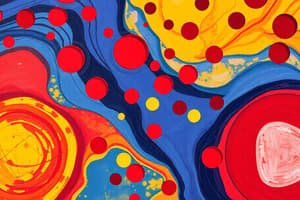Podcast
Questions and Answers
What characterizes idiopathic thrombocytopenic purpura?
What characterizes idiopathic thrombocytopenic purpura?
- Prolonged coagulation time
- Increased platelet count
- Prolonged bleeding time (correct)
- Normal bleeding time
What is a major cause of vitamin K deficiency?
What is a major cause of vitamin K deficiency?
- High consumption of green leafy vegetables
- Excessive dietary intake of vitamin K
- Prolonged use of corticosteroids
- Failure of absorption due to intestinal diseases (correct)
Which factor is deficient in Hemophilia A?
Which factor is deficient in Hemophilia A?
- Factor VIII (correct)
- Factor IX
- Factor XI
- Factor VII
What distinguishes hemophilia from thrombocytopenic purpura?
What distinguishes hemophilia from thrombocytopenic purpura?
Which vitamin is essential for the synthesis of coagulation factors II, VII, IX, and X?
Which vitamin is essential for the synthesis of coagulation factors II, VII, IX, and X?
What distinguishes Hemophilia C from other types of hemophilia?
What distinguishes Hemophilia C from other types of hemophilia?
What is the estimated normal platelet count in mm³?
What is the estimated normal platelet count in mm³?
What is the primary function of anti-coagulants?
What is the primary function of anti-coagulants?
Which of the following is an example of an in vitro anticoagulant?
Which of the following is an example of an in vitro anticoagulant?
What is the main mechanism of action for Heparin?
What is the main mechanism of action for Heparin?
What is the antidote used for reversing the effects of Dicoumarol?
What is the antidote used for reversing the effects of Dicoumarol?
Which type of purpura is due to a decrease in the number of platelets?
Which type of purpura is due to a decrease in the number of platelets?
What is the expected duration of action for Heparin?
What is the expected duration of action for Heparin?
Which condition is characterized by spontaneous punctate hemorrhages beneath the skin?
Which condition is characterized by spontaneous punctate hemorrhages beneath the skin?
What factor primarily leads to thrombocytopenic purpura?
What factor primarily leads to thrombocytopenic purpura?
Flashcards are hidden until you start studying
Study Notes
Anti-coagulants
- Substances that prevent or delay blood coagulation
- Types:
- In vivo: prevent blood coagulation inside the body
- In vitro: prevent blood coagulation outside the body
In vitro Anti-coagulants
- Methods to prevent blood coagulation outside the body:
- Cold: delays clotting
- Smooth lined vessels: prevent activation of Factor XII
- Decalcifying agents:
- Potassium Oxalate: precipitates calcium oxalate
- Sodium Citrate: combines with calcium to form unionized calcium compounds
- EDTA (Ethylenediaminetetraacetic acid): chelates calcium ions
- Heparin
In vivo Anti-coagulants
- Heparin:
- Origin: animal
- Latent period: few minutes
- Duration of action: 4-6 hours
- Route of administration: intravenous or intramuscular injection
- Mechanism of action:
- Inhibits prothrombin activator
- Inhibits prothrombin
- Inhibits thrombin (factors II, VII, IX and X)
- Site of action: in vivo and in vitro
- Anti-dote: protamine sulphate
- Dicoumarol:
- Origin: plant
- Latent period: 2 days
- Duration of action: few days
- Route of administration: oral
- Mechanism of action: competitive inhibition of vitamin K
- Site of action: in vivo only
- Anti-dote: vitamin K
Hemorrhagic Disorders
- Conditions that cause excessive bleeding in humans
Purpura
- Bleeding disease characterized by spontaneous punctuate hemorrhages under the skin and mucous membranes (petechiae) - appearing as purplish spots
- Types and causes:
- Thrombocytopenic purpura:
- Due to decreased platelet count (below 50,000/mm³)
- Causes:
- Decreased platelet production (bone marrow damage)
- Increased platelet destruction (hyperspleenism)
- Thromboesthenic purpura:
- Due to abnormal platelets in circulation
- Normal platelet count
- Idiopathic thrombocytopenic purpura:
- Unknown cause
- Thrombocytopenic purpura:
- Characteristics:
- Prolonged bleeding time
- Normal coagulation time
Vitamin K-Deficiency
- Causes:
- Failure of absorption of vitamin K: e.g. intestinal diseases
- Failure of vitamin K synthesis in the intestine by intestinal bacteria:
- Prolonged use of antibiotics
- Newborn infants
- Dicoumarol toxicity:
- Competitive inhibition of vitamin K by oral anticoagulants (dicoumarol)
- Severe lack of vitamin K in diet
- Effects:
- Bleeding tendency due to inhibition of formation of factors II, VII, IX, X, protein C and S in the liver
Hemophilia
- Sex-linked, inherited bleeding disease
- Characteristics:
- Transmitted by females to male infants
- Females do not suffer, making it sex-linked
- Severe and prolonged hemorrhage from injured vessels
- Prolonged coagulation time
- Normal bleeding time
- Cause:
- Hereditary deficiency of coagulation factors - mainly VIII, IX, and XI, leading to bleeding tendencies
- Types:
- Hemophilia A (Classic Hemophilia): deficiency of factor VIII - most common type
- Hemophilia B (Christmas disease): deficiency of factor IX
- Hemophilia C: deficiency of factor XI - rarest type
Comparing Hemophilia and Purpura
| Feature | Hemophilia | Purpura |
|---|---|---|
| Heredity | Inherited | Not inherited |
| Affected sex | Male only | Both male and female |
| Cause | Lack of clotting factors VIII, IX or XI | Lack of platelet number or function |
| Types | Hemophilia A, B, C | Thrombocytopenic, Thromboasthenic, Idiopathic |
| Bleeding time | Normal | Prolonged |
| Coagulation time | Prolonged | Normal |
Thrombocytes (Blood Platelets)
- Normal count: 250,000/mm³
- Manufactured in the bone marrow
Studying That Suits You
Use AI to generate personalized quizzes and flashcards to suit your learning preferences.




